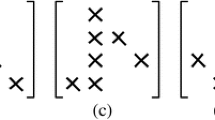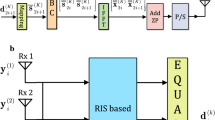Abstract
An efficient high order multi-user multiple-input multiple-output (MU-MIMO) subspace detector is proposed. The detector employs joint modulation classification (MC) and subspace detection (SD), by which the modulation type of the interferer is estimated, while multiple decoupled streams are individually detected. The algorithmic contributions are on two levels. First, the preprocessing channel matrix decomposition overhead is reduced, using special layer ordering followed by permutation-robust QR Decomposition and elementary matrix operations. Second, a hierarchical MC scheme is proposed, comprising feature-based and near-optimal likelihood-based classifiers, as well as a classifier that always assumes the interfering modulation type to be a fixed high order quadrature amplitude modulation. An efficient hardware architecture that realizes the proposed algorithms is presented. Simulations demonstrate that depending on the channel condition, one of the proposed schemes can achieve near interference-aware performance with a minimum complexity overhead.














Similar content being viewed by others
References
Duplicy, J., Biljana, B., Balraj, R., Ghaffar, R., Horváth, P., Kaltenberger, F., Knopp, R., Kovács, I., Nguyen, H., & Tandur, D. (2011). MU-MIMO in LTE systems. EURASIP Journal on Wireless Communications and Networking, 2011(1), 496–763.
Paulraj, A., Nabar, R., & Gore, D. (2003). Introduction to space-time wireless communications, Cambridge University Press.
Evolved universal terrestrial radio access (E-UTRA); physical channels and modulation. 3GPP Std. TS 36.211 http://www.3gpp.org.
Physical channels and mapping of transport channels onto physical channels. 3GPP Std. TS 25.211 http://www.3gpp.org.
IEEE standard for air interface for broadband wireless access systems. IEEE Std. 802.16 (2012). http://standards.ieee.org/getieee802/802.16.html.
IEEE standard for local and metropolitan area networks – part 11: Wireless LAN medium access control (MAC) and physical layer (PHY). IEEE Std. 802.11 (2012). http://standards.ieee.org/getieee802/802.11.html.
Hassibi, B., & Vikalo, H. (2005). On the sphere-decoding algorithm I. expected complexity. IEEE Transactions on Signal Processing, 53(8), 2806–2818.
Mansour, M.M., Alex, S.P., & Jalloul, L.M. (2014). Reduced complexity soft-output MIMO sphere detectors—part I: Algorithmic optimizations. IEEE Transactions on Signal Processing, 62(21), 5505–5520.
Mansour, M.M., Alex, S.P., & Jalloul, L.M. (2014). Reduced complexity soft-output MIMO sphere detectors—part II: Architectural optimizations. IEEE Transactions on Signal Processing, 62(21), 5521–5535.
Vikalo, H., & Hassibi, B. (2005). On the sphere-decoding algorithm II. generalizations, second-order statistics, and applications to communications. IEEE Transactions on Signal Processing, 53(8), 2819–2834.
Viterbo, E., & Boutros, J. (1999). A universal lattice code decoder for fading channels. IEEE Transactions on Information Theory, 45(5), 1639–1642.
Ariyavisitakul, S.L., Zheng, J., Ojard, E., & Kim, J. (2008). Subspace beamforming for near-capacity MIMO performance. IEEE Transactions on Signal Processing, 56(11), 5729–5733.
Mansour, M.M. (2015). A near-ML MIMO subspace detection algorithm. IEEE Signal Processing Letters, 22 (4), 408–412.
Mansour, M.M. (2015). A low-complexity MIMO subspace detection algorithm. EURASIP Journal on Wireless Communications and Networking, 2015(1), 1–11.
Siti, M., & Fitz, M.P. (2006). A novel soft-output layered orthogonal lattice detector for multiple antenna communications, Proceedings of the IEEE int. Conf. Commun. (ICC), (Vol. 4 pp. 1686–1691).
Jungwon, L., Toumpakaris, D., & Wei, Y. (2011). Interference mitigation via joint detection. IEEE Journal on Selected Areas in Communications, 29(6), 1172–1184.
Bai, Z., Badic, B., Iwelski, S., Scholand, T., Balraj, R., Bruck, G., & Jung, P. (2011). On the equivalence of MMSE and IRC receiver in MU-MIMO systems. IEEE Communications Letters, 15(12), 1288–1290.
Ghaffar, R., & Knopp, R. (2011). Interference sensitivity for multiuser MIMO in LTE, 2011 IEEE 12th international workshop on Signal processing advances in wireless communications (SPAWC) (pp. 506–510).
Ghaffar, R., & Knopp, R. (2011). Interference-aware receiver structure for multi-user MIMO and LTE. EURASIP Journal on Wireless Communications and Networking, 2011(1), 1–17.
Gomaa, A., Jalloul, L.M., Gomadam, K.S., Tujkovic, D., & Mansour, M.M. (2015). Multi-user MIMO receivers with partial state information. arXiv:1502.00212.
Bae, J.H., Kim, S., Lee, J., & Kang, I. (2012). Advanced downlink MU-MIMO receiver for 3GPP LTE-a, Proceeding of the IEEE int. Conf. Commun. (ICC) (pp. 7004–7008).
Dobre, O.A., Abdi, A., Bar-Ness, Y., & Su, W. (2007). Survey of automatic modulation classification techniques: classical approaches and new trends. Communications, IET, 1(2), 137– 156.
Wei, W., & Mendel, J.M. (2000). Maximum-likelihood classification for digital amplitude-phase modulations. IEEE transactions on Communications, 48(2), 189–193.
Panagiotou, P., Anastasopoulos, A., & Polydoros, A. (2000). Likelihood ratio tests for modulation classification, Proceedings of the IEEE MILCOM, (Vol. 2 pp. 670–674).
Hameed, F., Dobre, O.A., & Popescu, D.C. (2009). On the likelihood-based approach to modulation classification. IEEE Transactions on Wireless Communications, 8(12), 5884–5892.
Choqueuse, V., Azou, S., Yao, K., Collin, L., & Burel, G. (2009). Blind modulation recognition for MIMO systems. MTA Review, 19(2), 183–196.
Shim, B., & Kang, I. (2009). Joint modulation classification and detection using sphere decoding. IEEE Signal Processing Letters, 16(9), 778–781.
Ramezani-Kebrya, A., Kim, I.M., Kim, D.I., Chan, F., & Inkol, R. (2013). Likelihood-based modulation classification for multiple-antenna receiver. IEEE Transactions on Communications, 61(9), 3816–3829.
Sarieddeen, H., Mansour, M.M., Jalloul, L.M.A., & Chehab, A. (2015). Likelihood-based modulation classification for MU-MIMO systems, Proceedings of the IEEE global conf. on signal and inform. Process. (GlobalSIP) (pp. 873–877).
Dobre, O.A., Abdi, A., Bar-Ness, Y., & Su, W. (2010). Cyclostationarity-based modulation classification of linear digital modulations in flat fading channels. Wireless Personal Communications, 54(4), 699–717.
Muhlhaus, M.S., Oner, M., Dobre, O.A., Jkel, H.U., & Jondral, F.K. (2012). Automatic modulation classification for mimo systems using fourth-order cumulants, Proceedings of the IEEE vehic. Technol. Conf. (VTC) (pp. 1–5).
Muhlhaus, M.S., Oner, M., Dobre, O.A., Jakel, H.U., & Jondral, F.K. (2013). A novel algorithm for MIMO signal classification using higher-order cumulants, 2013 IEEE Radio and wireless symposium (RWS) (pp. 7–9).
Studer, C., Fateh, S., & Seethaler, D. (2011). ASIC implementation of soft-input soft-output MIMO detection using MMSE parallel interference cancellation. IEEE Journal of Solid-State Circuits, 46(7), 1754–1765.
Mansour, M.M., & Jalloul, L.M. (2015). Optimized configurable architectures for scalable soft-input soft-output MIMO detectors with 256-QAM. IEEE Transactions on Signal Processing, 63(18), 4969–4984.
Gomaa, A., & Jalloul, L.M.A. (2014). Efficient soft-input soft-output detection of dual-layer MIMO systems. IEEE Wireless Communications Letters, 3(5), 541–544.
Edelman, A. (1988). Eigenvalues and condition numbers of random matrices. SIAM Journal on Matrix Analysis and Applications, 9(4), 543–560.
Choi, J. (2006). Nulling and cancellation detector for MIMO and its application to multistage receiver for coded signals: performance and optimization, (Vol. 5.
Golub, G.H., & Van loan, C.F. (1996). Matrix Computations, 3rd edn. Baltimore: Johns Hopkins University.
William, G., & Chad, M.S. (1994). The cumulant theory of cyclostationary time-series, part I. IEEE Transactions on Signal Processing, 42(12), 3409–3429.
Sarieddeen, H., Mansour, M.M., & Chehab, A. (2016). Modulation classification via subspace detection in mimo systems, IEEE Communications Letters.
Sarieddeen, H., Mansour, M.M., & Chehab, A. (2016). Efficient near-optimal 8x8 mimo detector, Proceedings of the IEEE wireless commun. and netw. Conf. (WCNC) (pp. 1–6).
Acknowledgments
This work was partially funded by the National Council for Scientific Research (CNRS) in Lebanon.
Author information
Authors and Affiliations
Corresponding author
Additional information
Early results of this paper were presented at the IEEE Wireless Communication and Networking Conference (WCNC 2016), Doha, Qatar, April 2016. [41].
Rights and permissions
About this article
Cite this article
Sarieddeen, H., Mansour, M.M., Jalloul, L. et al. High Order Multi-User MIMO Subspace Detection. J Sign Process Syst 90, 305–321 (2018). https://doi.org/10.1007/s11265-017-1231-0
Received:
Revised:
Accepted:
Published:
Issue Date:
DOI: https://doi.org/10.1007/s11265-017-1231-0




